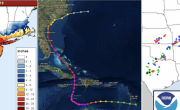Autumn 2019 | The Model Evaluation Tools (MET) were developed and released to the community by the Developmental Testbed Center more than a decade ago. At that time, the tools included computation of traditional statistics for continuous fields (temperature, pressure, and height) and dichotomous fields (precipitation, clouds, fog, and high impact events). MET also included a spatial verification method, using objects, which complemented traditional statistics. Over the past five years, new flexibility and… Read More
Announcement: Experimentation and Development of Physical Parameterizations for Numerical Weather Prediction Using a Single-Column Model and the Common Community Physics Package (CCPP)
AMS Short Course

2019-10-11 | The AMS Short Course on Experimentation and Development of Physical Parameterizations for Numerical Weather Prediction Using a single-column model and the Common Community Physics Package (CCPP) will be held on 12 January 2020 preceding the 100th AMS Annual Meeting in Boston, MA. Preliminary programs, registration, hotel, and general information will be posted on the AMS Web site. The goal of this course is to familiarize participants with new tools for experimentation and development of physical… Read More
Announcement: Short Course on Containers and Cloud Computing at AMS Annual - 12 Jan 2020
AMS Short Course

2019-10-10 | The Developmental Testbed Center (DTC) will host a short course on Integrating NWP System Components Using Container Technology and Cloud Services on 12 January 2020 preceding the 100th AMS Annual Meeting in Boston, Massachusetts. The goal of this course is to raise awareness about tools and facilities available to the community for testing and evaluating Numerical Weather Prediction (NWP) innovations, including the emerging set of software tools in reusable containers and cloud computing resources, through hands-on… Read More
Software Release: Announcing UPP V4.0.1 Bug Fix Release

2019-08-21 | Dear UPP Community, The Developmental Testbed Center (DTC) is pleased to announce the release of the Unified Post Processor Bug Fix Version 4.0.1. Significant bug fixes include: FV3GFS processing fix: Modified input format for processing FV3GFS data. Users should use UPPV4.0.1 for all FV3GFS processing. Previous versions are now considered legacy for FV3GFS. Users should use 'binarynemsiompiio' instead of 'binarynemsio' in their run script. The binarynemsio format option will not be supported in the future. Scripts in… Read More
Software Release: METplus 2.1.1 and MET 8.1.1 Bugfix Releases

2019-07-08 | Bugfix releases for both METplus version 2.1 and MET version 8.1 are now available. METPLUS 2.1.1 MAY BE OBTAINED ON GITHUB. MET 8.1.1 IS AVAILABLE FOR DOWNLOAD FROM THE MET USERS WEB PAGE.
Software Release: Common Community Physics Package (CCPP) v3.0 Release

2019-06-17 | The Common Community Physics Package (CCPP) v3.0 was publicly released in June 2019. The CCPP contains a library of physical parameterizations (CCPP-Physics), and the framework that connects it to host models (CCPP-Framework). In this release, the CCPP has been bundled with the Global Model Test bed (GMTB) Single Column Model (SCM) v3.0. The CCPP-Physics is envisioned to contain parameterizations used by NOAA operational models for weather through seasonal prediction timescales, as well as developmental schemes under… Read More
Bridges to Operations: Advanced Physics Testing

Spring 2019 | With funding from the Next Generation Global Prediction System (NGGPS) initiative and broad support from the community, the National Centers for Environmental Prediction (NCEP)/Environmental Modeling Center (EMC) recently replaced the dynamic core in its flagship operational model, the Global Forecast System (GFS). Version 15 of the GFS (GFSv15), implemented in operations on June 12, 2019, includes the Finite-Volume Cubed-Sphere (FV3) non-hydrostatic dynamical core in place of the long-running spectral hydrostatic core… Read More
Software Release: METplus 2.1 with MET 8.1 and METviewer 2.10 components

2019-05-03 | The Model Evaluation Tools (MET) development team at the DTC is pleased to announce the release of a multi-component verification capability called METplus. It includes METplus version 2.1, MET version 8.1 and METviewer version 2.10. METplus contains a suite of Python wrappers and ancillary scripts to enhance the user's ability to quickly set-up and run MET. METviewer is a database and display system for aggregating and plotting MET output. In the future, a user will be able to check everything out through the METplus… Read More
Lead Story: NOAA and NCAR partner on new modeling framework
NCAR and NOAA MOA

Spring 2019 | NCAR and NOAA are each adopting a unified approach to coupled environmental modeling, where success for both efforts is critically dependent on community contributions. At the end of January 2019, NCAR and NOAA signed a Memorandum of Agreement (MOA) to develop a shared infrastructure that encourages the broader community to engage in improving the Nation’s weather and climate modeling capabilities. Collaborating on the development of a common infrastructure will reduce duplication of effort and create common community… Read More
Director's Corner: The Operational FV3 Era
Clark Evans

Spring 2019 | We stand at the dawn of the operational FV3 era, representing the first step in the implementation of NOAA's Next-Generation Global Prediction System (NGGPS). With this new era comes many challenges, but also many opportunities to work collaboratively to improve the operational modeling system. How can NOAA best work with the community to leverage these opportunities and develop a truly world-class weather and climate prediction system? A few ideas: Develop a decadal vision for world-class numerical weather prediction.… Read More
Who's Who: Gerard Ketefian
Spring 2019 | Gerard Ketefian tries to “get big computers to tell him if it’s going to be sunny or rainy or snowy tomorrow, and the next day, and the day after that, and…” that’s how he explains his job to a child - and he has two -- a 2-year old boy and 4-year old girl. Gerard’s background is engineering. He has a B.S. in civil and mechanical engineering and M.S. in environmental engineering with emphasis on environmental fluid mechanics (both air and water). Gerard’s Ph.D. involved computational fluid dynamics applied to atmospheric… Read More
Visitors: Forecast Skill of the High-Resolution Rapid Refresh (HRRR) Model for Banded Snowfall Events
Visitor: Jacob Radford
Spring 2019 | Jacob Radford, a Ph.D. student at North Carolina State University and visitor to the DTC during June of 2018, investigated the forecast skill of the High-Resolution Rapid Refresh (HRRR) model for banded snowfall events. In particular, he evaluated the HRRR’s ability to capture the location, areal extent, orientation, and aspect ratio of these locally enhanced regions of reflectivity. In theory, snowbands should be adequately resolved by the HRRR thanks to its fine grid-spacing, but model skill has not yet been assessed… Read More
Community Connections: Model Evaluation for Research Innovation Transition (MERIT)

Spring 2019 | The Model Evaluation for Research Innovation Transition (MERIT) project provides a critical framework for physics developers to test innovations within their schemes using selected meteorological cases that have been analyzed in depth. Comparing their results to baseline MERIT simulations will allow developers to determine whether their innovations address model shortcomings and improve operational numerical weather prediction. For the DTC’s AOP 2018, three high-impact global FV3 baseline cases were selected for in-… Read More
Did you know?: There are Specialized Tools to Evaluate Innovations for NWP of TC's
Spring 2019 | Model Evaluation Tools – Tropical Cyclone (MET-TC) was first developed in 2012 by the Developmental Testbed Center (DTC) as part of the Hurricane Forecast Improvement Project (HFIP) to provide a set of tools to aid in tropical cyclone forecast evaluation and verification. The primary goal of MET-TC was to replicate the functionality of the National Hurricane Center (NHC) verification software while utilizing the modular tools available within the MET software framework. The MET-TC software was first released with METv4.1… Read More
Software Release: Announcing UPP V4.0 Release

2019-03-19 | Dear UPP Community, The Developmental Testbed Center (DTC) is pleased to announce the release of the Unified Post Processor Version 4.0. The UPP has a new webpage! Please update your bookmarks. https://dtcenter.org/community-code/unified-post-processor-upp Major Improvements and New Features include: Support for FV3GFS model output in NEMSIO format Updated User Guide documentation to include information on post-processing the FV3GFS model output. New output control files to produce fields from FV3GFS model output.… Read More
Pagination
Copyright © 2026. All rights reserved.